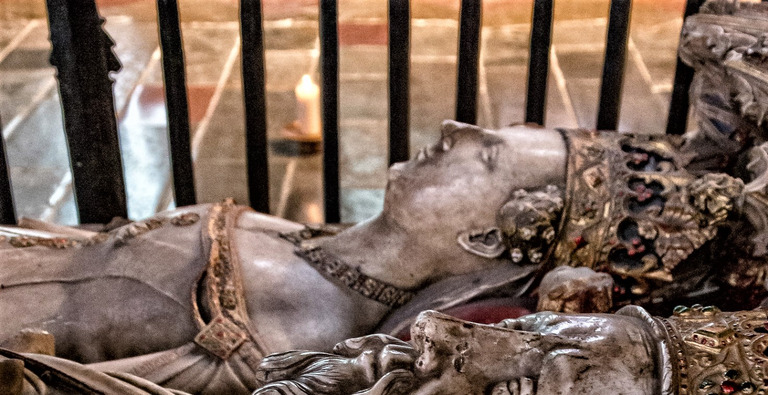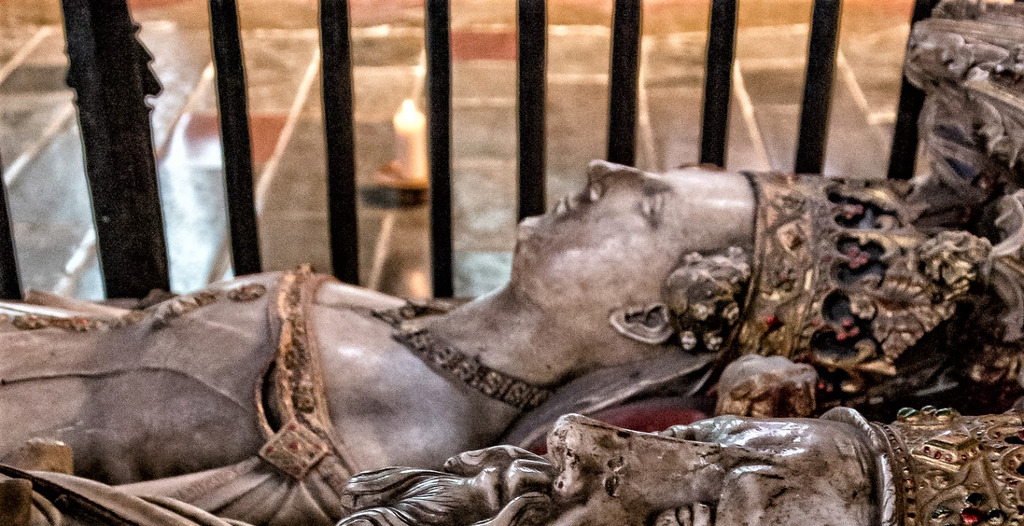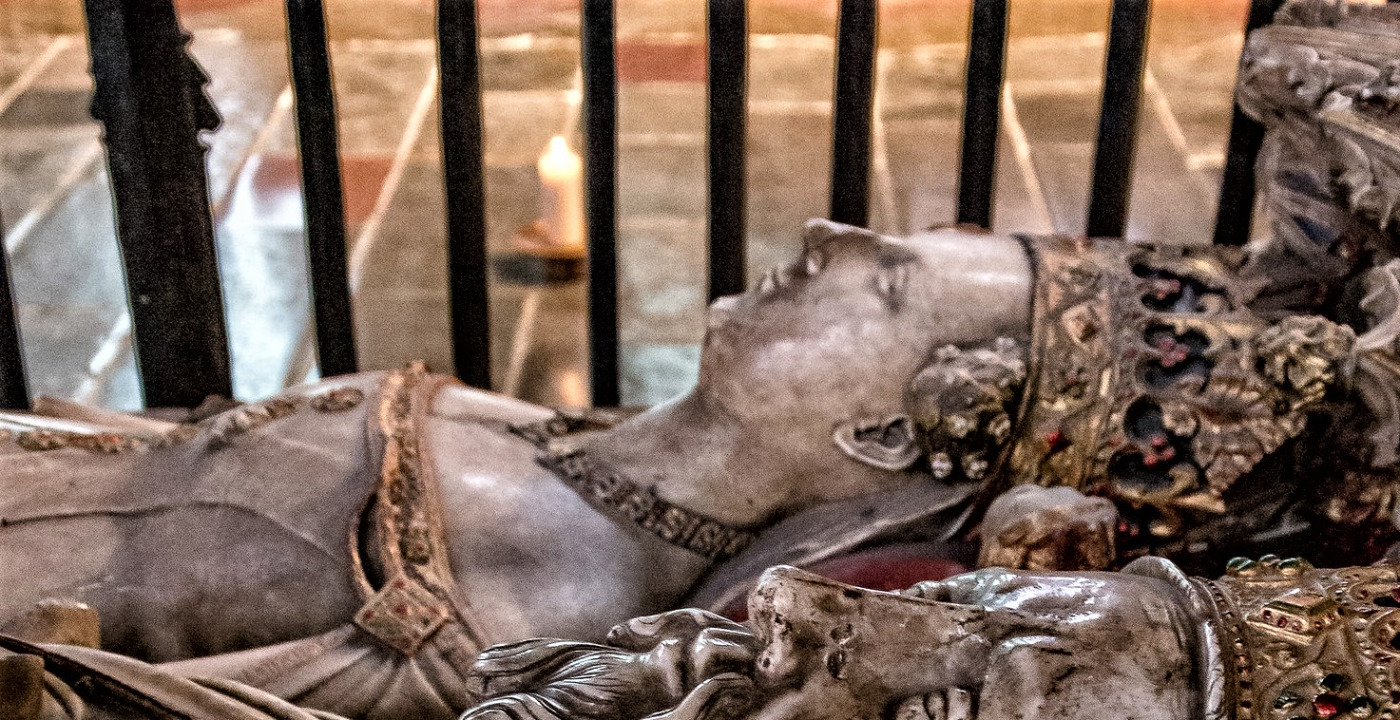Birth
Exact place and date unclear and disputed; likely Estella, Navarre in late 1368-before April 1369
Education
UnknownDeath
June 9th, 1437 in Essex, UKReligion
Roman CatholicJoan of Navarre became Queen consort of England after marrying Henry IV, King of England.
She was politically active throughout her life. Examples include her intercession with her husband first husband Jean IV, Duke of Brittany, to prevent potential war with France, petitions to her husband Henry IV and Parliament, and evidence of intercession during her reign as queen consort. Joan was an active and able regent for her son Jean V. She was also credited with diplomatic skills and used her connection between Brittany and England to attempt to secure peace.
Personal Information
Name(s)
Juana de Navarra (also known as Jeanne de Navarre or Joan of Navarre), Infanta of Navarre, Duchess of Brittany, Queen consort of England
Date and place of birth
Exact place and date unclear and disputed; likely Estella, Navarre in late 1368-before April 1369
Date and place of death
July 9, 1437 at Havering-atte-Bower, Essex, England
Family
Mother: Jeanne de Valois, Princess of France (1343-73), daughter of Jean II ‘le Bon’ King of France (1319-1364, r. 1350-1364) and Bonne de Luxembourg (1315-1349, black death), daughter of Jean de Luxembourg, King of Bohemia, sister of Charles IV, Holy Roman Emperor
Father: Carlos II ‘el Malo’ of Navarre (also known as Charles II ‘the Bad’ of Navarre, 1332-1387, r. 1349-1387), son of Juana II, Queen regnant of Navarre (1311-1349, r. 1329-1349) and Philppe d’Evreux (also known as Felipe III de Navarra, 1306-1343).
Marriage and Family Life
m.1: September 11, 1386 at Guérande, Brittany to Jean IV, Duke of Brittany (1339-1399, r. 1345/1365-1399, note Breton Civil War means that dates of his reign are difficult due to periods of exile)
issue of marriage:
- Jeanne (possibly twin girls, second Isabelle?) b. August 1387-d. December 7, 1388
- Pierre (later became Duke Jean V) b. December 24, 1389-d. August 29, 1442, r. 1399-1442.
- Marie b. 1391-d.1446, Duchess of Alençon
- Marguerite b. 1392-d.1428, Countess of Porhoët
- Arthur b. August 24, 1393-December 26, 1458, later Duke Arthur III, r. 1457-58
- Giles b. 1394-death disputed, possibly 1412
- Richard b. 1395-d. June 2, 1438
- Blanche b. 1397-d.1416, Countess of Armagnac
m.2: February 7, 1403 at Winchester Cathedral to Henry IV, King of England (1367-1413, r.1399-1413), no issue
Education
Little detail of her education is known apart from documents that confirm that she was being cared for and educated in her early childhood at the Convent of Santa Clara in Estella, Navarre.
Religion
Roman Catholic, adherent of the Anti-Pope in Avignon until her marriage to Henry IV of England (received dispensation to marry a ‘heretic’, i.e an adherent of the Roman Pope)
Transformation(s)
The death of Joan’s first husband in November 1399 was a significant moment in her life which made her regent of Brittany. Joan took decisive steps as regent to secure her son’s position and stabilize the duchy and also make a somewhat risky and controversial decision to contract a secret marriage with Henry IV, which secured her position as queen consort. However, while making a second marriage elevated her position to queen and it appears brought her personal happiness with her new husband, she had to leave Brittany and the majority of her children behind to make a new life in England. Thus, her move to England in early 1403 was a pivotal moment in her life, she remained in England for the rest of her life-another 34 years-carving out a place for herself with her new marital family and leaving her Breton family behind.
Contemporaneous Network(s)
Joan was part of a wide-ranging familial network which spanned across Europe, was the daughter, granddaughter, niece and cousin of kings and emperors. She carried Capetian blood in her veins through both sides of her family, and was closely related to the Valois kings of France. She was also connected to the most powerful nobles of France; the Dukes of Burgundy and Berry as well as the Counts of Foix and Armagnac. Through marriage, she became first Duchess of Brittany and later Queen of England-through the marriages of her family and stepchildren, she could claim links to the Kings of Bohemia, Castile, Aragon, Portugal and Sweden as well as the Dukes of Milan. These connections made her an attractive proposition for both of her husbands and gave her connections which she personally could leverage for personal and political benefit.
less
Significance
Works/Agency
Significant evidence of her political agency and activity throughout her life, examples include her intercession with her husband Jean IV to prevent potential war with France (see Chronique de Saint Denis, in the bibliography), petitions to her husband Henry IV and Parliament and evidence of intercession during her reign as queen consort (examples in the Parliament Rolls, Calendar of Patent Rolls and the SC8 series in the National Archives, Kew). Joan proved to be an active and able regent for her son Jean V, from her husband’s death in November 1399 until December 1402, shortly before she left for England to marry Henry IV. Joan was also credited with diplomatic skills and used her connection between Brittany and England to attempt to secure peace-one example is a truce between her stepson Henry V of England and her son Jean V of Brittany which was said to have been achieved through her influence and efforts (see the Foedera, November 16, 1417). Throughout her life, she fought vociferously to obtain her rights and dues, bringing suits and petitions as well as negotiating with rulers and royal councils to ensure that she retained her lands and rents and thus had adequate funds to maintain her position and household. Joan was also a cultural patron who commissioned her first husband’s tomb (see Brooton, in the bibliography) and may have been involved in the commission for her second husband’s tomb (which she shares) at Canterbury Cathedral. She was the patron of the famous composer John Dunstable as well.
Reputation
Joan’s reputation, both during her lifetime and in later historiography has been decidedly mixed, from merely absent to those sources which criticize her for being avaricious or an absentee parent. For more on her reputation as a mother, see Woodacre, in the bibliography. The accusation of witchcraft (see Controversy) has also had a lasting impact on her reputation, however as she was never charged or tried identifying her as a ‘royal witch’ is highly problematic.
Legacy and Influence
Joan’s most lasting visual legacy is her joint tomb with her husband, Henry IV at Canterbury Cathedral, which she may have commissioned (see images). Other images of Joan or her arms can be found in stained glass windows at Winchester and Lincoln Cathedrals and in the Jerusalem Chamber at Westminster Abbey (the location of her second husband, Henry IV of England’s death).
less
Controversies
Controversy
Joan was accused by her stepson Henry V of treason in September 1419 and was held under house arrest until August 1422. Some contemporary chronicles interpreted this potentially treasonous activity as necromancy or witchcraft and this has forever tarnished her reputation, leaving the lasting impression that Joan was a “royal witch”. She was never formally charged or tried, and many historians have suggested that that this was a flimsy pretext for Henry V to seize his stepmother’s generous dower lands and rents to help fund his Continental campaigns or perhaps was a means of stunting her political agency and diplomatic activity with her relatives in Brittany and France. However, this charge has remained notable and controversial, given the rarity of queens who have been accused of treason and particularly witchcraft or necromancy.
less
Bibliography
Primary: (Selected)
Bellaguet, Louis. ed. Chronique du Reliqieux de Saint-Denys contenant le régne de Charles VI de 1380 a 1422. Vols. I-IV. Paris: Imprimerie de Crapelet, 1839-42.
Blanchard, René. ed. Lettres et Mandements de Jean V, Duc de Bretagne. 5 vols. Nantes: Société des Bibliophiles Bretons, 1889-1895.
Jones, Michael ed. Recueil des actes de Jean IV, duc de Bretagne, t.II, nos. 431-1196 (1383-1399). Torquay: Devonshire Press, 1983.
Morice, Dom Hyacinthe. Memoires pour servir de preuves a l'histoire ecclesiastique et civile de Bretagne. 2 vols. Paris: Charles Osmont, 1742-46.
Walsingham, Thomas, The Chronica Maiora of Thomas Walsingham 1376-1422. Translated by David Prest and notes and introduction by James G. Clark. Woodbridge: Boydell, 2005.
See also printed calendars of the Patent, Signet, Close and Fine Rolls from the reigns of Henry IV, V and VI of England and the Archivo General de Navarra, Catálogo de la Seccion de Comptos, vols VII-LII
Archival resources: (Selected)
Brittany: ADLA (Loire Atlantique), B & E Series (Trésor des Chartes)
AIV (Ile-et-Vilaine), 1 E series and F (Borderie collection)
England: TNA (National Archives, Kew) series including (but not limited to) E101, E404, E199, C 1, SC 6
Secondary Sources (selected recent scholarship):
Booton, Diane E. “Commemorating Duke John IV of Brittany in Ritual and Image.” Nottingham Medieval Studies 59 (2015): 157-86.
Jones, Michael. “Between France and England: Jeanne de Navarre, duchess of Brittany and queen of England (1386-1437).” In Between France and England: Politics, Power and Society in Late Medieval Brittany, 1-23. Aldershot: Variorum, 2003.
Myers, A.R. "The Captivity of a Royal Witch: The Household Accounts of Queen Joan of Navarre, 1419-21." Bulletin of the John Rylands Library 24. 2 (1940): 263-284.
Woodacre, Elena. Joan of Navarre: Infanta, Duchess, Queen, Witch? London: Routledge, 2022.
Web resources:
Inquisitions Post-Mortem in the Mapping the Medieval Countryside project: http://www.inquisitionspostmortem.ac.uk/
The Gascon Rolls project: http://www.gasconrolls.org/en/
Issues with the Sources
Joan has become one of the lesser-known queens of England due to a paucity of sources which focus on her. She is barely mentioned in contemporary English chronicles, partly due to her lack of children-queens are often mentioned in medieval chronicles in connection with life cycle events such as their marriage, coronation and the births of their children, which was key to dynastic continuity. As Joan and Henry had no children (both had several from their first marriages), she elicited little mention and her husband’s turbulent reign was the primary focus of the chronicles, rather than his wife. This has led many to believe that Joan either did little of note or that there are no sources available to study her life and the resulting lack of dedicated studies of her life, with the exception of Michael Jones’ brief overview and the new full-length biography by Woodacre which finally fills this gap in scholarship. However, engaging with European chronicles and other archival sources, particularly financial, legal, diplomatic and administrative ones, reveal her very active engagement in all of these areas on a courtly, national and international level (see examples in the bibliography).



Comment
Your message was sent successfully